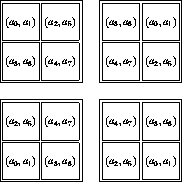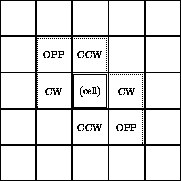The table in Figure ![]() shows how the bits in the Margolus
neighborhood are used to index the lookup tables that will define the
rule of evolution.
shows how the bits in the Margolus
neighborhood are used to index the lookup tables that will define the
rule of evolution.

Figure: Margolus neighborhoods by parity
Following the general custom by which rule tables are defined, the
states of the cells are regarded as digits to be arranged in some
standard order; Figure ![]() establishes that order for the
Margolus neighborhood. The states have internal structure, so plane 0
is taken as providing the low order bit, plane 1 the high order bit for
a cell of four states; this is acknowledged by filling the table with
pairs.
establishes that order for the
Margolus neighborhood. The states have internal structure, so plane 0
is taken as providing the low order bit, plane 1 the high order bit for
a cell of four states; this is acknowledged by filling the table with
pairs.
Each different number corresponds to some distribution of the states around the neighborhood; to form the lookup table that is the number indexing the array in which the new value of the state for that particular neighborhood is recorded.
The ``central'' cell occupies a different corner of its neighborhood according to the parity of its coordinate, which is the reason that the table contains four versions of the arrangement of the neighborhood.

Figure: Parity can be reversed between generations
With a view toward constructing rules for reversible evolution, one of the restrictions could be that the new states be a permutation of the old ones, given the understanding that permutations themselves are reversible; there are 120 permutations of four objects.
The layout of the screen panel is fairly typical, but so far has not been subject to the pressures and accommodations of prolonged usage.